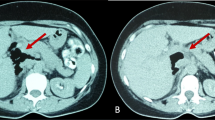Abstract
To determine management guidelines for symptomatic duodenal diverticulum, we reviewed medical records of 26 patients. Complicated duodenal diverticulum was the only possible cause of symptoms-abdominal pain, fever and chills, melena, vomiting-in 18 patients. Ten patients improved with conservative management, and eight patients underwent diverticulectomy with or without various other procedures. Among the eight patients, one patient who had duodenal fistula died of respiratory complications on the second postoperative day. Symptoms recurred in two patients: One had a distal common bile duct (CBD) stricture and underwent choledochojejunostomy. In the other patient a CBD stone developed 3 years later, and choledocholithotomy and choledochojejunostomy were performed. Eight patients had associated gallstone disease as well as the diverticulum. Five of the eight had a history of operation for gallstone disease; four improved with conservative treatment, and one underwent choledochojejunostomy. Two patients were thought to have an innocent diverticulum and underwent cholecystectomy and choledocholithotomy only. One patient underwent diverticulectomy and sphincteroplasty for a CBD stone and pervaterian diverticulum. In conclusion, operations for duodenal diverticulum should be reserved for seriously complicated diverticula, and the surgeon should be aware that pervaterian diverticulum can be a cause of choledocholithiasis.
Résumé
Pour déterminer une attitude thérapeutique vis-à-vis du diverticule duodénal symptomatique, nous avons revu 26 dossiers médicaux. On a estimé que des symptômes comprenant douleur abdominale, fièvre, frissons, méléna et vomissements, observés chez 18 patients, étaient en rapport avec un diverticule duodénal compliqué. Dix patients ont été traités de façon conservatrice, alors que huit patients ont eu une diverticulectomie associée ou non à un autre procédé. Parmi ces huit patients, un patient qui avait eu une fistule duodénale est décédé au deuxième jour. Les symptômes ont récidivé chez deux patients. Un de ces patients, ayant une sténose de la voie biliaire principale, a eu ensuite une anastomose cholédocojéjunale. Le dernier patient a développé une lithiase de la voie biliaire principale trois ans après, qui a nécessité une cholédocotomie suivie d'une anastomose cholédocojéjunale. Huit patients avaient aussi une lithiase vésiculaire associée à leur diverticule. Cinq des huit patients avaient déjà eu une opération pour leur lithiase, quatre ont été améliorés par un traitement conservateur et un autre a eu une anastomose cholédocojéjunale. Chez deux patients ayant un diverticule asymptomatique, seule une cholécystectomie et une cholédocotomie ont été pratiquées. Un patient a eu une diverticulectomie et une sphinctérotomie pour lithiase cholédocienne et diverticule paravatérien. En conclusion, le traitement du diverticule duodénal doit être réservé pour les cas compliqués et le chirurgien devrait savoir que le diverticule paravatérien peut éventuellement être une cause de lithiase cholédocieme.
Resumen
Con el objeto de definir una guía de manejo para el divertículo duodenal sintomático, revisamos las historias clínicas de 26 pacientes. El divertículo duodenal complicado fue la única causa de síntomas-dolor abdominal, fiebre y escalofrios, melena, vómito—en 18 pacientes. Diez pacientes tuvieron mejoría con manejo conservador y 8 fueron sometidos a diverticulectomía con o sin olros procedimientos concomitantes. Entre estos ocho, uno, que tenía fistula duodenal, murio por complicación respiratoria en el segundo día postoperatorio. Síntomas recurrieron en dos pacientes. Uno de ellos presentaba estenosis de la via biliar distal, por lo cual se construyó una coledoyeyunostomía. En el otro, apareció coledocolitiasis 3 años más tarde, por lo cual se practicó coledocolitotomía y coledocoyeyunostomía. Ocho pacientes presentaban coleitiasis asociada: 5 de los 8 tenian historia de operación por colelitiasis y 4 mejoraron con manejo conservador y en 1 se practicó coledocoyeyunostomía. Dos pacientes parecían tener divertículos inocentes y fueron sometidos a colecistectomía y coledocolitotomía solamente. En uno se practicó diverticulectomía y esfinteroplastia por coledocolitiasis y un divertículo pervateriano. En conclusión, la operación para el divertículo duodenal debe ser reservada para los divertículos con complicaciones graves y el cirujano debe tener conciencia de que el diveriículo pervateriano puede ser causa de coledocolitiasis.
Similar content being viewed by others
References
Curtis, L.E., O'Grady, T.J.: Duodenal diverticulitis with spontaneous perforation. J.A.M.A. 195:582, 1966
Sherroll, A., Neil, M.D., Thompson N.W.: The complications of duodenal diverticula and their management. Surg. Gynecol. 120:1251, 1965
Jones, T.W., Mrendino, K.A.: The perplexing duodenal diverticulum. Surgery 48:1068, 1960
Shocket, E., Simon, S.A.: Small bowel obstruction due to enterlith (bezoar) formation of a duodenal diverticulum: a case report and review of the literature. Am. J. Gastroentrol. 77:621, 1982
Scudamore, C.H., Harrison, R.C., White, T.T.: Management of duodenal diverticula. Can. J. Surg. 24:311, 1982
Donald, J.W.: Major complications of small bowel diverticula. Ann. Surg. 190:183, 1979
Landor, J.H., Fukersoin, C.C.: Duodenal diverticula: relationship to biliary tract disease. Arch. Surg. 93:182, 1966
Cattell, R.B., Mudge, T.J.: The surgical significance of duodenal diverticula. N. Engl. J. Med. 246:317, 1952
Nelson, J.A., Burhenne, H.J.: Anomalous biliary and pancreatic duct insertion into duodenal diverticula. Radiology 120:49–52, 1976
Pinotti, H.W., Tacla, M., Pontes, J.F., Bettarello, A.: Surgical procedures upon juxtaampullar duodenal diverticula. Surg. Gynecol. Obstet. 135:11, 1972
Kaminsky, H.H., Thompson, W.R., Davis, B.: Extended sphincteroplasty for juxtapapillary duodenal diverticulum. Surg. Gynecol. Obstet. 162:281, 1986
Critchlow, J.F., Shaphiro, M.E., Silen, W.: Duodenojejunostomy for the pancreaticobiliary complications of duodenal diverticulum. Ann. Surg. 202:56, 1985
Mcsherry, C.K., Glenn, F.: Biliary tract obstuction and duodenal diverticula. Surg. Gynecol. Obstet. 130:829, 1970
Løtveit, T., Osnes, M., Larsen, S.: Recurrent biliary calculi: duodenal diverticula as a predisposing factor. Ann. Surg. 196:30, 1982
Osnes, M., Lotveit, T., Larsen, S., Aune, S.: Duodenal diverticula and their relationship to age, sex and biliary calculi. Scand. J. Gastroenterol. 16:103, 1981
Suzuki, N., Yamachuchi, H., Takahashi, W., Sato, T.: Peripapillary duodenal diverticulum and biliary tract disease. Jpn. J. Surg. 14:480, 1984
Author information
Authors and Affiliations
Rights and permissions
About this article
Cite this article
Jang, L.C., Kim, S.W., Park, Y.H. et al. Symptomatic duodenal diverticulum. World J. Surg. 19, 729–733 (1995). https://doi.org/10.1007/BF00295916
Issue Date:
DOI: https://doi.org/10.1007/BF00295916




